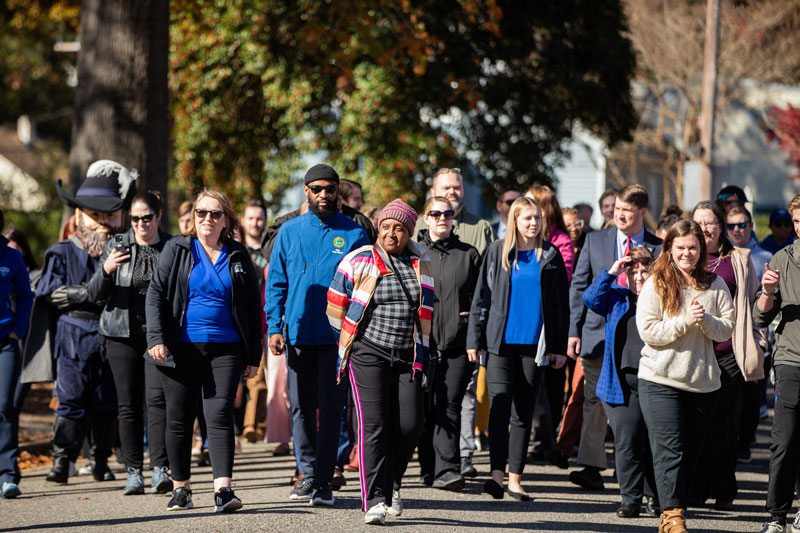
Read time:
Shoe Lane provides the southern boundary of the University and two recent events underscore that it is no humdrum city street.
On November 13, about 200 University and Newport News leaders were joined by students, faculty, staff, and local residents for a Community Walk. The group set off from campus and strolled along Shoe Lane to Riverside Elementary School.
The week before, an even larger group gathered for a community conversation - “What Happened on Shoe Lane and Why It Matters” - to learn more about the University’s early history.
As it was known then, Christopher Newport College was located along Shoe Lane because of a controversial decision by the City of Newport News in 1961. History Professor Dr. Phil Hamilton has written: “The 60 acres themselves were owned by a small community of African Americans. Thus many Blacks across the Peninsula thought the City Council was attempting to use the college as a way to remove these Black landowners and halt further African American migration into this section of town.”
The decision and the land seizures that followed are controversial to this day and have been the focus of recent news media coverage. Hamilton was one of the panelists for the discussion, along with Geography Professor Dr. Johnny Finn and three voices from outside the campus: Norfolk State University Professor Cassandra Newby-Alexander, Hampton historian Audrey Perry Williams, and Pastor William Spencer of First Baptist Church Morrison. Regina Brayboy ‘84, chair of the President’s Council on Diversity, Equity and Inclusion and a member of the Board of Visitors, served as the moderator.
Before introducing Brayboy, President William G. Kelly set the tone for the program: “Our goal is to learn about and more deeply understand our history as an institution…There are many more steps to come and this conversation will help us all understand how to take those steps in the right direction. Today, the University is in listening and learning mode.”
The discussion was illuminating and, at times, emotional. The audience included current Shoe Lane-area residents and the descendents of homeowners displaced by the city’s decision. The panelists and members of the audience thanked the University for exploring a painful chapter in its growth.
Several in the audience criticized the Walker’s Green historic marker on Shoe Lane that is a tribute to one former Shoe Lane family. They said it doesn’t fully depict the struggle in the 1960s and the pain that followed. They urged University leaders to better educate students about CNU’s complicated history and to do more to assist the uprooted families. A video of the full conversation is available here.
Six days later, Kelly led a walk that took literal steps toward a deeper understanding of the neighborhood adjoining campus. The President leads popular early-morning weekly walks around campus. The Community Walk took that idea in a new direction. The goal was to demonstrate to residents along Shoe Lane and nearby streets that CNU strives to be a good neighbor. Another goal was to give students, faculty and staff an opportunity to learn more about the people and the places close to campus.
Kelly was joined by Newport News Police Chief Steve Drew, uniformed officers, city officials, and representatives of Newport News Public Schools. Captain Chris was at the front and University staff pulled a cart full of sidewalk chalk at the rear.
That chalk was a gift to the students of Riverside Elementary School, the turn-around point midway through the walk. Riverside Principal Tim Edwards welcomed the group and the Boomin Bears Drumline brought music and spirit to the gathering. Kelly joined the children in a “Go Bears” chant, quickly followed by his trademark, “Go Captains!”
Kelly then led the return to campus with a turn off Shoe Lane to Walker’s Green, the final footfalls in a week that saw significant steps toward a deeper understanding of the University’s history and the place it calls home.